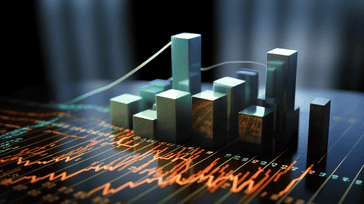Interest Rates and their Influence on Economic Indicators

Understanding the role of interest rates in the economy is crucial for investors and economics enthusiasts alike. Interest rates have a significant impact on various economic indicators, and changes in these rates can have far-reaching consequences. This section will explore the relationship between interest rates and economic indicators, providing an overview of the importance of economic data and highlighting the role of interest rates in shaping economic trends.
Key Takeaways
- Economic indicators provide insights into the overall health and performance of the economy.
- Interest rates can impact economic indicators, influencing economic trends and financial indicators.
- Understanding the relationship between interest rates and economic indicators is essential for investors and economics enthusiasts.
- Changes in interest rates can affect various economic indicators, such as consumer spending, investment, employment, and the housing and stock markets.
- Analyzing economic data in relation to interest rates can provide valuable insights for investment and economic analysis.
Understanding Economic Indicators
Economic indicators provide essential information to measure a country's economic performance. They are data points used to analyze and assess the overall health of an economy. Economic indicators are essential for businesses, governments, and investors in forecasting economic trends.
Economic indicators definition: They are statistical metrics that are used to assess and measure the overall health of a country's economy. Economic data is collected and analyzed by economists, businesses, investors, and governments to make informed decisions.
There are different types of economic indicators, including leading, lagging, and coincident indicators. Leading indicators, such as the Consumer Confidence Index, show potential changes in the economy before they happen. Lagging indicators, such as the unemployment rate, reflect changes that have already occurred. Coincident indicators, such as GDP, move in tandem with the economy.
Economic statistics can be presented in various forms, including tables, graphs, and charts. In the table below, we will provide a few examples of commonly used economic indicators.
| Economic Indicator | Description |
|---|---|
| Gross Domestic Product (GDP) | The total value of goods and services produced in a country within a specific time |
| Consumer Price Index (CPI) | A measure of the average prices of goods and services purchased by households |
| Unemployment Rate | The percentage of the labor force that is unemployed but actively seeking employment |
| Manufacturing Purchasing Managers Index (PMI) | A measure of manufacturing activity in a country's economy |
As you can see, economic indicators provide critical information about the state of the economy. Understanding economic data is vital in making informed decisions about investments, business operations, and public policy.
The Role of Interest Rates in the Economy

Interest rates play a significant role in shaping economic trends and financial indicators. The Federal Reserve (Fed) sets the target range for the federal funds rate – the interest rate that banks charge each other for overnight loans – which has a ripple effect across the economy.
When interest rates are low, borrowing costs decrease, which leads to increased spending and investment. This can stimulate economic growth and job creation, which can boost consumer confidence and further drive spending. Conversely, high-interest rates can slow down economic activity, which can lead to decreased investment and hiring.
The Fed adjusts interest rates to help achieve its dual mandate of maximum employment and price stability. Therefore, interest rates can be seen as a barometer of the economy's health and performance. Changes in interest rates can signal shifts in economic trends, which may impact financial markets and investor behavior.
"A low-interest-rate environment may be good for borrowers, but it can also lead to higher inflation, which can negatively impact financial markets."
The Federal Reserve's Monetary Policy and Interest Rates
The Fed's monetary policy decisions can impact the direction of interest rates. When the economy is experiencing growth or inflation, the Fed may increase interest rates to mitigate inflationary pressures. Alternatively, the Fed may decrease interest rates to stimulate economic activity during times of recession or slow growth.
| Date | Interest Rate | Reason for Change |
|---|---|---|
| March 15, 2020 | 0.00-0.25% | COVID-19 pandemic |
| December 16, 2015 | 0.25-0.50% | Improving economic conditions |
| December 16, 2008 | 0.00-0.25% | Financial crisis |
The Impact of Interest Rates on Financial Indicators
Interest rates can impact various financial indicators, such as the stock market, bond yields, and foreign exchange rates. A decrease in interest rates can boost stock prices as investors seek higher returns in the equity market. Conversely, a rise in interest rates can lead to a decrease in bond prices, as investors seek higher yields.
Lower interest rates can also lead to a weaker currency, as lower yields decrease the relative attractiveness of a country's assets to foreign investors. On the other hand, higher interest rates can lead to a stronger currency, as investors seek the higher returns offered by a country's assets.
Conclusion
Interest rates play a crucial role in shaping economic trends and financial indicators. Understanding the impact of interest rate changes on the economy can help investors make informed decisions and prepare for potential shifts in the market.
Interest Rates and Inflation
The relationship between interest rates and inflation is one of the most crucial factors in understanding economic performance. As interest rates directly impact borrowing costs, changes in interest rates can have a significant impact on inflation rates.
When interest rates rise, borrowing becomes more expensive, leading to a decrease in demand for goods and services. As a result, businesses may need to lower their prices to stimulate demand. This decrease in prices can lead to a reduction in inflation rates.
On the other hand, if interest rates are low, borrowing becomes cheaper, leading to an increase in demand for goods and services. This increase in demand can lead to an increase in prices, which can result in higher inflation rates.
The impact of interest rates on inflation rates can have significant implications for economic performance. High inflation rates can lead to decreased economic growth, as businesses and consumers may be hesitant to invest in a volatile economy. Low inflation rates, on the other hand, may signal a stagnant economy with little growth potential.
Overall, it is crucial to monitor the relationship between interest rates and inflation when analyzing economic data and making investment decisions.
Interest Rates and Consumer Spending

Interest rates play a significant role in influencing consumer spending, as they impact borrowing costs for households. When interest rates are high, borrowing money becomes more expensive, which can discourage people from taking out loans for big-ticket items like cars or homes. On the other hand, when interest rates are low, borrowing becomes more affordable, making it easier for consumers to make purchases.
As one of the most significant economic indicators, consumer spending is crucial for economic growth. It makes up a significant portion of the gross domestic product (GDP), which measures the overall size and performance of the economy. Economists and investors closely monitor consumer spending patterns to gauge economic health and identify trends.
"Consumer spending drives the economy, and interest rates can significantly influence it. When rates are low, consumers are more likely to spend, which can lead to economic growth."
However, it's essential to note that interest rates are just one of many factors that influence consumer spending. Other factors, like income levels, employment rates, and consumer confidence, can also play a role in shaping spending habits. A thorough economic analysis must consider all of these factors when assessing the impact of interest rates on consumer spending.
When analyzing the relationship between interest rates and consumer spending, there are various economic indicators to consider. Retail sales, for example, measure consumer purchases at retail stores and can provide insight into consumer spending trends. Personal consumption expenditures (PCE), which measure consumer spending on goods and services, can also offer valuable economic data.
Overall, interest rates can significantly impact consumer spending, making it a crucial economic indicator to monitor and analyze. By considering interest rates alongside other economic indicators, investors and economics enthusiasts can gain valuable insights into economic performance and make informed investment decisions.
Interest Rates and Investment
Interest rates play a crucial role in influencing investment decisions made by businesses. When interest rates rise, borrowing costs increase, which can discourage businesses from taking out loans to fund investments. On the other hand, when interest rates fall, borrowing costs decrease, making it more attractive for businesses to invest and expand.
As a result, interest rates can impact the level of investment in an economy, which in turn affects economic performance. High levels of investment can lead to economic growth and job creation, while low levels of investment can result in economic stagnation and unemployment.
According to economic data, there is a strong correlation between interest rates and investment, with businesses typically increasing investment when interest rates are low and decreasing investment when interest rates are high. In addition, the Federal Reserve can use interest rates as a tool to stimulate or slow down the economy by adjusting the federal funds rate, which can impact the cost of borrowing for businesses.
| Interest Rates | Investment |
|---|---|
| High | Low |
| Low | High |
As the table above demonstrates, there is an inverse relationship between interest rates and investment, with high interest rates leading to low investment and vice versa.
Therefore, when analyzing investment patterns and economic performance, it is essential to consider the influence of interest rates. By monitoring the relationship between interest rates and investment, investors and economists can gain valuable insights into the overall health and direction of the economy.
Interest Rates and Employment

The relationship between interest rates and employment is a crucial aspect of understanding how the economy works. Interest rates can influence business expansion and investment, which, in turn, can impact hiring decisions. Thus, changes in interest rates can have far-reaching implications for employment levels and the unemployment rate, which are key economic indicators related to the labor market.
The unemployment rate is one of the most-watched economic indicators, and it measures the percentage of the labor force that's unemployed and actively seeking work. Interest rates can affect the unemployment rate in several ways. For example:
"Higher interest rates lead to increased borrowing costs, which can make it harder for businesses to expand and create new jobs. Conversely, lower interest rates can make it easier for businesses to borrow money and invest in expansion."
Thus, changes in interest rates can have a significant impact on the labor market, affecting both job creation and the unemployment rate. In times of high unemployment, policymakers may use monetary policy to lower interest rates to stimulate growth and job creation. However, this approach also risks increasing inflation, making it a delicate balancing act for policymakers to strike.
It's essential to monitor employment levels in relation to interest rates and other economic indicators to understand economic trends and performance. The following table shows the correlation between interest rates and unemployment rates in the US from 2010 to 2020:
| Year | Interest Rates | Unemployment Rate |
|---|---|---|
| 2010 | 0.25% | 9.6% |
| 2011 | 0.25% | 8.9% |
| 2012 | 0.25% | 8.1% |
| 2013 | 0.25% | 7.4% |
| 2014 | 0.25% | 6.2% |
| 2015 | 0.25% | 5.3% |
| 2016 | 0.50% | 4.9% |
| 2017 | 1.25% | 4.4% |
| 2018 | 2.50% | 3.9% |
| 2019 | 2.50% | 3.7% |
| 2020 | 0.25% | 14.8% |
As we can see from the data, interest rates were at an all-time low from 2010 to 2016, while the unemployment rate decreased gradually, hitting a low of 3.9% in 2018. These trends were reversed in 2020, with interest rates remaining at a low of 0.25%, while the unemployment rate increased dramatically due to the COVID-19 pandemic.
The relationship between interest rates and employment is complex, and policymakers must balance the need for job creation with the risk of inflation. Investors and economics enthusiasts must watch interest rates, unemployment levels, and other economic indicators to make informed decisions and gain a comprehensive understanding of economic trends and performance.
Interest Rates and Housing Market
The housing market is a significant piece of the economy, and interest rates have a considerable impact on the market's performance. The cost of borrowing for home buying is heavily influenced by interest rates. As interest rates fluctuate, so do mortgage rates and the level of demand for housing. As a result, changes in interest rates affect the housing market's affordability and the housing industry's health, which can have broader economic implications.
When interest rates are low, mortgage rates decrease, which makes the cost of borrowing for home buying more affordable. This often results in an increase in demand for housing, leading to a rise in home prices. On the other hand, when interest rates are high, mortgage rates increase, making the cost of borrowing for home buying more expensive. This often results in a decrease in demand for housing, leading to a decline in home prices.
| Interest Rate | 30-Year Fixed Mortgage Rate | New Home Sales (Monthly) |
|---|---|---|
| 3.5% | 2.75% | 870,000 |
| 4.5% | 3.4% | 750,000 |
| 5.5% | 3.9% | 640,000 |
The table above demonstrates how changes in interest rates impact both mortgage rates and new home sales. As interest rates increase, 30-year fixed mortgage rates and new home sales decrease. When interest rates decrease, 30-year fixed mortgage rates and new home sales increase. These correlations display the significance of interest rates and the impact they have on the housing market.
Economic analysis of the housing market is crucial because it provides insight into broader economic trends. When the housing market is healthy, it often indicates overall economic growth. Alternatively, when the housing market is struggling, it can act as an early signal of an economic downturn. This is because the housing market is interconnected with other sectors of the economy, including employment, consumer spending, and investment.
Therefore, investors and economists must monitor housing market trends and its relationship with interest rates. By assessing housing market indicators such as home sales, home prices, and mortgage rates, investors and economists can develop a more in-depth understanding of overall economic performance.
The Bottom Line
Interest rates have a significant impact on the housing market. When interest rates rise, mortgage rates increase, making borrowing more expensive, and demand for housing can decline, leading to a potential decrease in home prices. Conversely, when interest rates fall, borrowing becomes more affordable, and demand for housing may increase, leading to a potential rise in home prices. As the housing market is a crucial economic indicator, investors and economists must pay close attention to its performance and its relationship with interest rates.
Interest Rates and Stock Market
Interest rates can significantly impact the stock market and investor behavior. It is essential to understand this relationship to make informed investment decisions and interpret market trends accurately.
When interest rates rise, borrowing costs increase, making it more expensive for businesses to borrow money for investment. This can reduce their profits, leading to a decline in stock prices. Investors tend to move their money out of stocks and into fixed income securities when interest rates rise, resulting in a drop in demand for stocks and a potential decrease in stock valuations.
Conversely, when interest rates fall, borrowing costs decrease, making it cheaper for businesses to borrow and invest. This can increase their earnings and lead to a rise in stock prices. Investors may move their money out of fixed income securities and into stocks when interest rates fall, boosting demand for stocks and potentially driving up stock valuations.
The impact of interest rates on the stock market is not always straightforward and can depend on various factors, including economic conditions, inflation rates, and investor sentiment. Analyzing economic indicators alongside interest rates is crucial for investors to make informed decisions and manage their portfolios effectively.
Analyzing Economic Indicators in Relation to Interest Rates
When assessing economic performance, it is crucial to consider the impact of interest rates on various economic indicators. Economic indicators are statistical data points that provide insight into the health of the economy. Some commonly used economic indicators include GDP (Gross Domestic Product), CPI (Consumer Price Index), and unemployment rates.
Interest rates are a significant factor in determining the overall health of the economy, and changes in interest rates can impact economic indicators in various ways. For instance, high-interest rates can lead to decreased consumer spending, resulting in lower GDP growth.
Economic analysis involves assessing the relationship between interest rates and economic indicators. By analyzing the impact of interest rates on various indicators, investors can make informed decisions regarding their investments.
GDP and Interest Rates
GDP is a vital economic indicator that measures the value of all the goods and services produced within a country's borders. Changes in interest rates can significantly impact GDP growth. For example, when interest rates are low, borrowing costs for businesses and consumers decrease. The resulting increase in spending can lead to higher demand for goods and services, ultimately resulting in increased GDP growth.
Conversely, high-interest rates can lead to decreased borrowing and spending, leading to a decline in GDP growth. When analyzing GDP in relation to interest rates, it is essential to consider other factors that may influence GDP growth, such as government spending and international trade.
Inflation and Interest Rates
Inflation is the rate at which the cost of goods and services increases over time. Changes in interest rates can impact inflation rates. High-interest rates can lead to decreased borrowing and spending, resulting in decreased demand for goods and services. This decrease in demand can lead to lower prices, ultimately resulting in lower inflation rates.
Low-interest rates, on the other hand, can lead to increased borrowing and spending, resulting in higher demand for goods and services. This increase in demand can lead to higher prices, resulting in higher inflation rates.
Employment and Interest Rates
Employment is a crucial economic indicator that measures the number of people who are currently employed. Changes in interest rates can impact employment levels. When interest rates are low, businesses may be more willing to borrow and invest in their operations, resulting in increased hiring. Conversely, high-interest rates can lead to decreased borrowing and investing, resulting in decreased hiring.
When analyzing employment in relation to interest rates, it is essential to consider other factors that may influence employment levels, such as government regulations and shifts in the labor force.
Financial Indicators and Interest Rates
Financial indicators, such as stock market performance and bond yields, can also be impacted by changes in interest rates. When interest rates are low, borrowing costs decrease, resulting in increased demand for bonds and stocks. This increased demand can lead to increased bond prices and higher stock market valuations.
When interest rates are high, borrowing costs increase, resulting in decreased demand for bonds and stocks. This decreased demand can lead to decreased bond prices and lower stock market valuations.
Conclusion
Analyzing economic indicators in relation to interest rates is an essential aspect of economic analysis. By understanding how changes in interest rates can impact various economic indicators, investors can make informed decisions that maximize their returns.
Conclusion
In conclusion, economic indicators play a crucial role in assessing the overall health and performance of the economy. Understanding the significance of these indicators and how they are influenced by interest rates is essential for investors and economics enthusiasts alike.
As discussed in this article, interest rates have a significant impact on various economic indicators, including inflation, consumer spending, investment, employment, housing market, and the stock market. Changes in interest rates can influence economic trends and performance in both positive and negative ways, highlighting the importance of monitoring and analyzing economic data.
By considering interest rates when interpreting economic indicators, investors can make informed decisions and maximize their returns. It is also important to note that economic indicators and interest rates are interdependent, meaning that changes in one can impact the other.
Overall, a comprehensive understanding of economic indicators and interest rates is vital for anyone interested in navigating the complex world of finance and economics. By keeping an eye on these indicators and staying up to date with economic trends, individuals and businesses can make informed decisions and thrive amidst an ever-changing economic landscape.
FAQ
What are economic indicators?
Economic indicators are statistical measures used to assess the overall health and performance of an economy. They provide information about various aspects of economic activity, such as employment, inflation, GDP, consumer spending, and more.
How do interest rates influence economic indicators?
Interest rates can have a significant impact on economic indicators. For example, changes in interest rates can affect borrowing costs for businesses and households, which can influence consumer spending and investment levels. Additionally, interest rates play a role in shaping inflation rates and financial market trends.
What is the relationship between interest rates and inflation?
Interest rates and inflation are closely linked. When interest rates are low, it can stimulate borrowing and spending, which can lead to increased demand and potentially higher inflation. Conversely, higher interest rates can have a dampening effect on borrowing and spending, which can help control inflationary pressures.
How do interest rates impact consumer spending?
Changes in interest rates can affect consumer spending by influencing borrowing costs. When interest rates are low, it becomes cheaper to borrow money for purchases such as homes, cars, or personal loans. This can increase consumer spending. On the other hand, higher interest rates can make borrowing more expensive, which can lead to a decrease in consumer spending.
What role do interest rates play in investment?
Interest rates play a crucial role in investment decisions. When interest rates are low, it becomes more affordable for businesses to borrow money for investments in expansion, new equipment, or research and development. Conversely, higher interest rates can increase borrowing costs, which can impact business investment decisions.
How do interest rates influence employment?
Changes in interest rates can impact employment in several ways. Lower interest rates can stimulate business expansion and investment, which can lead to job creation. Conversely, higher interest rates can increase borrowing costs for businesses, potentially impacting their hiring decisions. The relationship between interest rates and employment is complex and depends on various economic factors.
How do interest rates affect the housing market?
Interest rates can significantly impact the housing market. When interest rates are low, it can make mortgages more affordable, increasing demand for homes and potentially driving up prices. Conversely, higher interest rates can make borrowing more expensive, which can decrease housing affordability and dampen demand in the housing market.
What is the impact of interest rates on the stock market?
Interest rates can have a significant impact on the stock market. When interest rates are low, it can make stocks relatively more attractive compared to fixed-income investments like bonds. This can potentially lead to increased demand for stocks, driving up stock prices. Conversely, higher interest rates can make fixed-income investments more appealing, potentially leading to a decrease in stock prices.
Why is it important to consider interest rates when analyzing economic indicators?
Interest rates are a critical factor to consider when analyzing economic indicators because they can provide insights into the overall health and direction of the economy. Changes in interest rates can influence various aspects of economic activity, such as borrowing costs, consumer spending, investment levels, inflation rates, and financial market trends. Understanding the relationship between interest rates and economic indicators is crucial for making informed investment decisions and assessing economic performance.